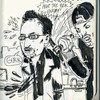Welcome back to Routine Moments in Baseball History, a running weekday feature that looks back at plays that have been ignored by the history books because history books only talk about things that are important or interesting. Today's installment is "Box Score Mysteries."Baseball people are the fussiest people on the planet. No other sport has media personalities who will spend hours condemning someone for something as simple as an exuberant bat flip; no other group of fans would try to obsessively track everything that happens during a game like the baseball people who keep score do. The upside of this fastidiousness is that we have a record of every game ever played, and practically every single out since the 1920s. If you want to know what happened during any game in the last century you can just go to baseball-reference.com and take a look. That's pretty much what I do when I write these Routine Moments—I'm forever indebted to whatever anal-retentive scorekeeper was keeping track of exactly what happened in 1960 when Joe Adcock hit a weak fly ball to left.But sometimes you run into something that can't be described in box score shorthand, and I ran into such a thing while looking at the August 21, 1978, game between the Los Angeles Dodgers and the Montreal Expos. In the bottom of the fifth, with the home team down 2-1 and right fielder Del Unser at second, this happened: "Single to SS; Unser Scores/Adv on E6/unER; Dawson to 2B." In layman's terms, Andre Dawson hit a ball to Dodgers shortstop Bill Russell that was sharp enough to be ruled a hit, but then Russell screwed up and let Unser score and Dawson get to second. The question is, how did he screw up?OK, so obviously if Russell stopped the ball from leaving the infield he could have stopped Unser from scoring—the baserunner was 33 years old and didn't have the speed to get from second to home on an infield single. Maybe Unser tried to get to home on the play and Russell's throw to catcher Joe Ferguson was off the mark? Except Unser, a veteran, wouldn't have attempted such a risky run. More likely, Russell tried to throw to first baseman Steve Garvey to get Dawson out, but the ball sailed into the stands, letting both runners advance a base. Except we don't know any of that for sure. Nor do we know what sort of ball Russell was fielding in the first place—it could have been a trickily hit bouncer that the scorekeeper decided to call a single, it could have been a roller into the hole between short and second base that Russell just barely got to before making a rushed throw that missed Garvey by a mile. Russell's motions are obscured by time. We know he made a mistake that let the tying run score, but we can't see him—he's a mess of arms and limbs and a glove floating in our heads, throwing the ball someplace, though we can't see where. His error is enshrined in the history books and will remain online until the internet burns out or humanity is extinguished, whichever comes first, but what he actually did that day 36 years ago is lost forever.This has been Routine Moments in Baseball History. Follow Harry Cheadle on Twitter.
